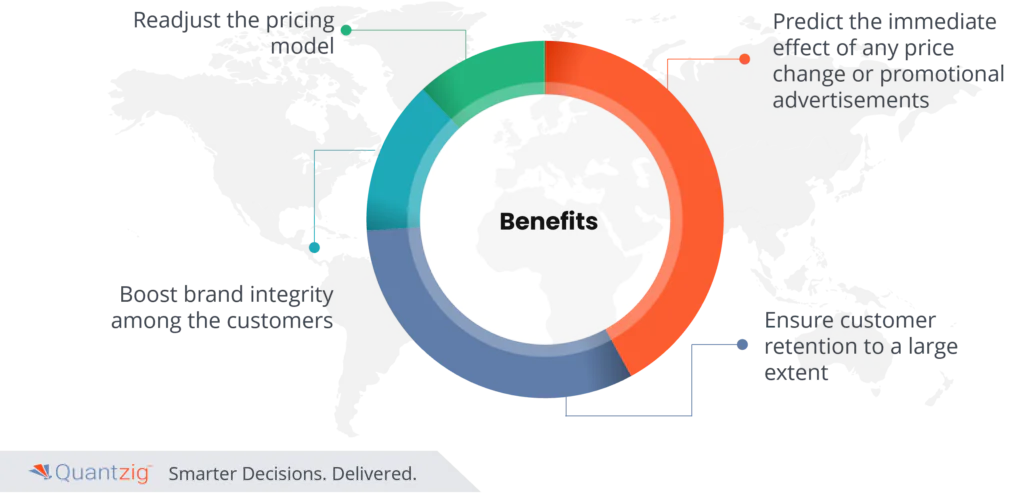In the dynamic landscape of the food industry, maintaining a competitive edge requires strategic pricing methodologies. Quantzig, a leading analytics and advisory firm, has recently collaborated with a prominent Frozen Food Manufacturer to revolutionize their pricing and food marketing analysis strategy. This partnership aims to enhance profitability by implementing advanced pricing analytics techniques. By leveraging predictive pricing strategies, Quantzig empowers the client to navigate the complexities of the market and make data-driven decisions.
In the ever-evolving frozen food sector, where consumer preferences and market dynamics fluctuate, a robust pricing strategy becomes paramount. Quantzig’s expertise in pricing analytics equips the manufacturer with insights to optimize pricing structures, identify market trends, and tailor strategies that resonate with consumer demands. This engagement is not merely a transactional process; it is a transformative journey towards boosting profit margins through food marketing analysis and ensuring sustained success in a competitive marketplace. Stay tuned to witness how this collaboration reshapes the pricing landscape for the frozen food industry, setting new benchmarks for profitability and strategic pricing excellence.
Table of Contents
Food marketing analysis current trends
- Rise of Digital Marketing in the Food Industry: With the increasing reliance on technology and online platforms, food businesses are leveraging social media campaigns, email marketing, and SEO strategies to enhance brand visibility and engage with customers. Utilizing platforms like Foodpanda and Zomato for advertising and partnership opportunities has become commonplace, while optimizing Google Maps profiles ensures easy discoverability for local consumers, reflecting a shift towards digital-first marketing approaches.
- Focus on Health and Sustainability: Consumers are increasingly prioritizing health-conscious and sustainable food choices, prompting food marketers to emphasize these aspects in their branding and messaging. From highlighting organic ingredients and environmentally-friendly packaging to partnering with brands that share similar values, food businesses are capitalizing on the growing demand for ethically sourced and nutritious options, thus shaping their brand positioning and product offerings.
- Experiential Marketing and Events: Hosting events such as happy hours, food festivals, and experiential pop-ups allows food businesses to create memorable experiences for consumers while showcasing their products. Partnering with other brands for collaborative events not only expands reach but also reinforces brand associations and fosters community engagement. Creatives On Call play a crucial role in conceptualizing and executing these events, ensuring they align with the brand’s image and resonate with the target audience.
- Personalization and Customization: Food marketers are increasingly adopting personalized marketing strategies to cater to individual consumer preferences and behaviors. From tailored email marketing campaigns to customized product packaging and offerings, businesses are leveraging data analytics to understand consumer trends and deliver personalized experiences. This focus on customization not only enhances customer satisfaction but also fosters brand loyalty, driving repeat purchases and long-term profitability in the competitive food industry landscape.
What the Client Wanted
The frozen food manufacturer enlisted Quantzig to conduct a comprehensive pricing analytics study aimed at optimizing product pricing strategies, enhancing customer retention, and ensuring sustained profitability in the fiercely competitive frozen food market. Leveraging advanced analytics techniques, the study aims to identify key pricing management initiatives that align with market dynamics, consumer preferences, and industry trends. By integrating data-driven insights, the manufacturer wanted to refine its pricing strategies, foster customer loyalty, and solidify its position within the market, ultimately driving long-term success amidst intense competition.
The Outcome

The pricing analytics study conducted by the experts revealed pricing misalignments which helped the frozen food manufacturer readjust their pricing model. In addition to augmenting the client’s profit margin, the new strategy also predicted the immediate effect of any price change or promotional advertisements. The optimized pricing strategy and food marketing analysis boosted brand integrity among the customers thereby ensuring customer retention to a large extent.
Leveraging historical price data can help you adjust the price of a product in order to maximize profits. To learn how we can help you analyze price data,
Request a free pilotGlobal Frozen Food Market
In a fast-paced life, consumers are exhibiting an increasing preference for frozen food market products which comprise of deep-frozen food products which can be stored and consumed over a long period of time. Other factors like a boost in the buying power, changing food habits, and the growing number of large retail chains have also accelerated the demand drivers of the frozen food market. This exponential growth has prompted prominent frozen food companies to expand their product portfolio in the market. However, growth in this otherwise thriving frozen food market is not bereft of challenges.
Industry Challenges
- Preference towards fresh and organic food – It is a common belief among most of the consumers that in order to increases the shelf-life of the product, the frozen food companies utilize preservatives and harmful packaging materials. Such apprehension deters health-conscious consumers from exploring products of the frozen food market and has consequently increased scopes for competitors who bring the promise of food products that are organic and fresh.
- Competitive pricing – In a crowded frozen food market ecosystem, one of the biggest challenges for the frozen food companies is to devise a strategic pricing model aligning to the competitive market pricing while ensuring a steady profit margin and retain customers. The companies find it difficult to stick to a steady price strategy while allocating resources for product innovation and campaigns.
- Navigating Intense Competition in the Frozen Food Industry: In a landscape saturated with packaged food manufacturers, grocers, and convenience stores vying for consumer attention, standing out becomes paramount. Crafting a compelling brand positioning and leveraging unique selling points (USPs) such as innovative product packaging or sustainable sourcing can help differentiate amidst competitors. Implementing strategic partnerships with other brands and optimizing digital marketing content for platforms like Foodpanda and Zomato can expand market reach and drive sales, combating the challenges of market saturation and intense competition.
- Ensuring Effective Brand Communication Across Digital Channels: With social media campaigns, blogging, and email marketing dominating modern marketing strategies, maintaining a consistent brand voice and engaging content becomes crucial. Challenges arise in effectively reaching and resonating with target audiences amidst the noise of digital platforms. Utilizing copywriters and content marketers skilled in crafting SEO blog content can enhance visibility and organic traffic. Additionally, optimizing Google Maps profiles and leveraging email marketing tactics tailored to food festivals and events can bolster brand presence and foster consumer engagement.
- Adapting to Evolving Consumer Preferences and Trends: The frozen food industry must continuously evolve to meet shifting consumer demands for healthier options, sustainable practices, and convenience. Revamping brand image, product packaging, and marketing strategies to reflect these changing preferences is imperative. Hosting events like happy hours or participating in food festivals provides opportunities to showcase products and connect directly with consumers. Creatives On Call can play a crucial role in conceptualizing and executing innovative marketing campaigns that resonate with target audiences, ensuring relevance and longevity in the dynamic food market landscape.
With the help of Quantzig’s Pricing Analytics dashboard solutions, a lot of businesses are able to reap significant commercial gains. Are you interested in our solutions?
Request a free demo
Highly Effective Food Marketing Strategies
- Utilizing Social Media Campaigns: Leveraging platforms like Instagram, Facebook, and Twitter allows food businesses to connect with their audience on a personal level, showcasing visually appealing content and engaging with customers in real-time. By partnering with influencers or running targeted ad campaigns, businesses can effectively reach their target demographics and drive brand awareness, ultimately boosting sales and fostering brand loyalty in the competitive food industry landscape.
- Emphasizing Product Packaging and Branding: In the crowded shelves of grocers, supermarkets, and convenience stores, eye-catching product packaging and cohesive branding are essential for standing out. By incorporating brand colors, unique design elements, and conveying the brand’s story and values through packaging, businesses can captivate consumers’ attention and differentiate themselves from competitors, influencing purchase decisions and strengthening brand positioning.
- Optimizing Online Presence and SEO: With an increasing number of consumers turning to the internet for food-related information and purchases, optimizing online presence through SEO strategies and maintaining accurate Google Maps profiles is paramount. By ensuring visibility in local search results and capitalizing on platforms like Foodpanda and Zomato, businesses can attract nearby customers and drive foot traffic to their establishments, ultimately increasing sales and revenue.
- Creating Memorable Experiences through Events: Hosting events such as happy hours, food festivals, and themed dining experiences provides opportunities for businesses to engage with customers in-person and create memorable experiences. By partnering with other brands or local organizations, businesses can expand their reach, foster community connections, and reinforce their brand image and values, ultimately enhancing customer loyalty and generating positive word-of-mouth referrals in the competitive food and beverage industry.
About the Client
A reputed frozen food manufacturer based out of the US.
Client’s Challenge
The client lacked a functional perspective of the diversifying frozen food market which was why they were unable to plan an optimized price strategy for their products. It caused the frozen food companies to suffer a setback in beating their competitor’s price on a contract to supply to leading food retailers.
To know more about how our pricing analytics solution helped the frozen food market client,
Request a free proposalBusiness Impact
A careful pricing analytics solution done by Quantzig’s pricing analytics experts helped the frozen food manufacturer in determining factors for an accurate pricing performance measurement. The solution aided the client in devising a predictive pricing model which allowed them visibility of the actual profitability of the products in a competitive frozen food market. This helped in their critical decision- making process in adjusting their product portfolio with respect to price, state or local tax and production and supply chain costs. It boosted profit for the frozen food manufacturer and gave an edge over the frozen food companies.
Pricing Analytics Solution Insights
Quantzig’s pricing analytics solution benefits the frozen food market by offering real-time updates on the product demand and purchase behavior of the customers. This helps the frozen food companies is shaping an elastic pricing strategy which can be adjusted according to product performance against price. The pricing analytics solution also helps adopting a structured approach to brand campaigning which can facilitate significant cost-savings.
Pricing Analytics Solution Insights
Pricing analytics is paramount in the food and beverage industry, where competition is fierce, and consumer preferences constantly evolve. By leveraging data-driven insights, businesses can make informed decisions to optimize pricing strategies and maximize profitability.
Analyzing market trends and competitor pricing allows food businesses, including packaged food manufacturers, grocers, restaurants, and bars, to identify opportunities for competitive pricing while maintaining profitability. Utilizing tools like Google Maps profiles and platforms such as Foodpanda and Zomato provides valuable data on consumer behavior and preferences, enabling businesses to tailor pricing strategies to specific market segments.
Additionally, partnering with other brands or food service distributors can offer economies of scale, enabling businesses to negotiate better pricing terms with suppliers and distributors, ultimately reducing costs and improving margins.
Implementing this tool also helps businesses understand the impact of pricing on customer retention and brand positioning. By aligning pricing strategies with brand values and unique selling points (USPs), businesses can enhance brand perception and loyalty among consumers.
Moreover, this tool can inform strategic decisions regarding promotional activities such as happy hours, food festivals, and other events. By analyzing the effectiveness of promotions in driving sales and attracting customers, businesses can optimize their promotional strategies to maximize ROI while minimizing discounting.
In conclusion, pricing analytics is a powerful tool for food and beverage businesses seeking to stay competitive in today’s dynamic market landscape. By leveraging data-driven insights and strategic partnerships, businesses can optimize pricing strategies to maximize profitability, enhance brand positioning, and drive long-term success in the industry. Collaborating with experts such as Creatives On Call, copywriters, and content marketers ensures that pricing strategies are effectively communicated to target audiences, ultimately driving organic traffic and increasing sales through digital marketing content optimized for SEO and social media campaigns.


